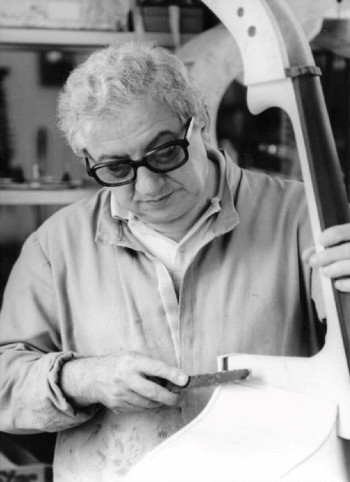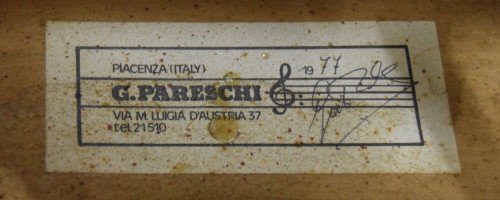Gabriele Pareschi
Ferrara, 18 marzo 1924 - Casalmaggiore (CR), 15 agosto 1996
BIOGRAFIA
Gabriele Pareschi, son of the famous luthier Gaetano, was born in Ferrara on 18th March 1924, the last descendant of an ancient Emilian family of luthiers and musicians.
His Grandfather Giovanni played the mandolin, while his father, Gaetano (1900-1987), called Rino, played the violin, and his brother Giancarlo, who, like Gabriele, graduated from the conservatory in Ferrara, devoted himself to the life of a concert player, and at the age of 22 he moved to South America, becoming shoulder soloist of the Symphony Orchestra of the Municipal Theatre of Rio de Janeiro, occupying this position for more than thirty years.
Gabriele married Ester in 1944 and the following year their son Gianfranco was born; the couple stayed together for about ten years.
In 1950 after graduating from the Conservatory, he taught accordion, thus founding his own school in Ferrara. In those years he played with jazz orchestras and performed with the orchestra of "Ugo Orsatti" in various events at the Bussola in Viareggio and recorded about ten discs until 1960.
In 1960 he opened a music shop in Ferrara, where he lived at 8 Via Camposabbionario together with his father Gaetano until 1969 . In 1967, he reunited with his first wife, who had been suffering from lungs for some time. Unfortunately she died two years later at the age of 44.
After having "patented" a hammer mechanism for pianos that hit metal cylinders creating a more electronic and cold sound, Gabriele, a really genius person, proposed the idea to Davoli, founder and owner of a well-known company of musical instruments, the “Krundaal Davoli”, which built enormously successful amplification systems all over the world, also with numerous other productions of musical instruments.
Following this fruitful collaboration, Gabriele and Davoli founded the company "Musical DAVOLI s.r.l" thus starting to work on the piano project "C77", which was widely used in those years, enjoying great acclaim as well as a profitable commercial success.
In the meantime Gabriele decided to move to Pilastro, a few kilometres from the company located in the small hamlet of Langhirano, in the province of Parma along with the whole family including the now elderly father Gaetano” until 1975.
The following year, in 1976, after meeting his second wife Ada who worked in Milan, he sold the house in Ferrara and moved with his family to Piacenza in via Maria Luigiad'Austria.
Here he begins to follow the art of his father, who was old but present and very active mentally, still gifted with great talent, he taught the art and tradition that characterized him by a long career and great fame. Gabriele learned the notions, procedures and working phases from his father, but he always tried to evolve and put his own in the constructionof instruments, thanks to his experiments.
In the same year, due to space requirements, he bought a real workshop that was a small carpentry shop in Rottofrenoin the province of Piacenza.
In 1979 he moved with his family to Cavacurta, a hamlet of Castelgerundo in the province of Lodi, where Gabriele found a small house with an adjoining workshop.
In those years the double bass found wide use above all in jazz music. According to the market needs of the period, Gabriele began to offer his double basses at affordable prices, which in a short time made them become enormously popular. A strong demand came above all from England as these instruments were considered more accessible with a truly remarkable quality/price ratio, and reduced delivery times as well as comfortable to play and with a decent acoustics, much appreciated especially by students and teachers who favoured the requests.
Following the great demand for double basses, he modernized the traditional tools of the trade, in particular the gouges, making them electrified, thus “inventing” the first electric gouge. Cit.!
From 1980 to 1990 the major production of instruments was concentrated in Cavacurta, he built several violins, a few violas on his own model, about twenty cellos, and more than 60 double basses using almost always the same modern shape with high shoulders and classic varnish.
Also gifted with a good knowledge of market needs and a strong entrepreneurial sense, for a few years he saw a good popular and economic response.
In Cavacurta he also opened a stationery shop at 11 via Matteotti and in May 1985 he became a municipal councilor.
On 13th April 1987 his father Gaetano died in Cavacurtaand after a few months also his mother Anita did.
Both of them were buried in the local cemetery.
In 1991 he gave up his activity as a luthier, because he was ill in the lungs, due to prolonged inhalations of woody dusts. He moved to Lecco and sold his workshop in Cavacurta.
In 1992 he finally decided to get close to his son Gianfranco, who lived in the province of Cremona, where he spent some peaceful years delighting in the production of pipes and bringing his son closer to the luthier business, building with him two instruments still jealously guarded. Gianfranco, a talented drummer, as per family tradition, however, devoted himself mainly to the activity of a musician, performing with local orchestras.
Gabriele died suddenly of a heart attack in Casalmaggiore (CR) on 15thAugust 1996.
Excerpt from the biography in progress “Gabriele Pareschi, musicista inventore e liutaio” written by Matteo Marsili and Gianfranco and Antonella Pareschi, 2020/2021.
Translation by Prof. Giovanna Leani.
Info:
Matteo Marsili: marsiliviolins@outlook.it
To be published in 2025:
"PARESCHI storia di una famiglia ferrarese nella liuteria del ‘900" (PARESCHI story of a Ferrara family in 20th century violin making)
Info: Matteo Marsili: liutaio.marsili@gmail.com


